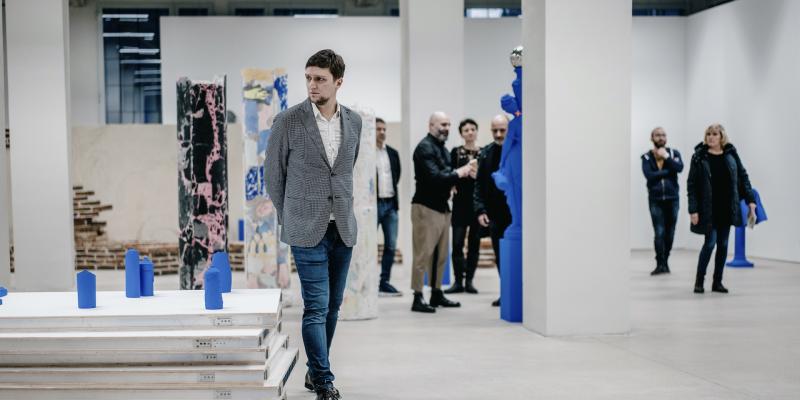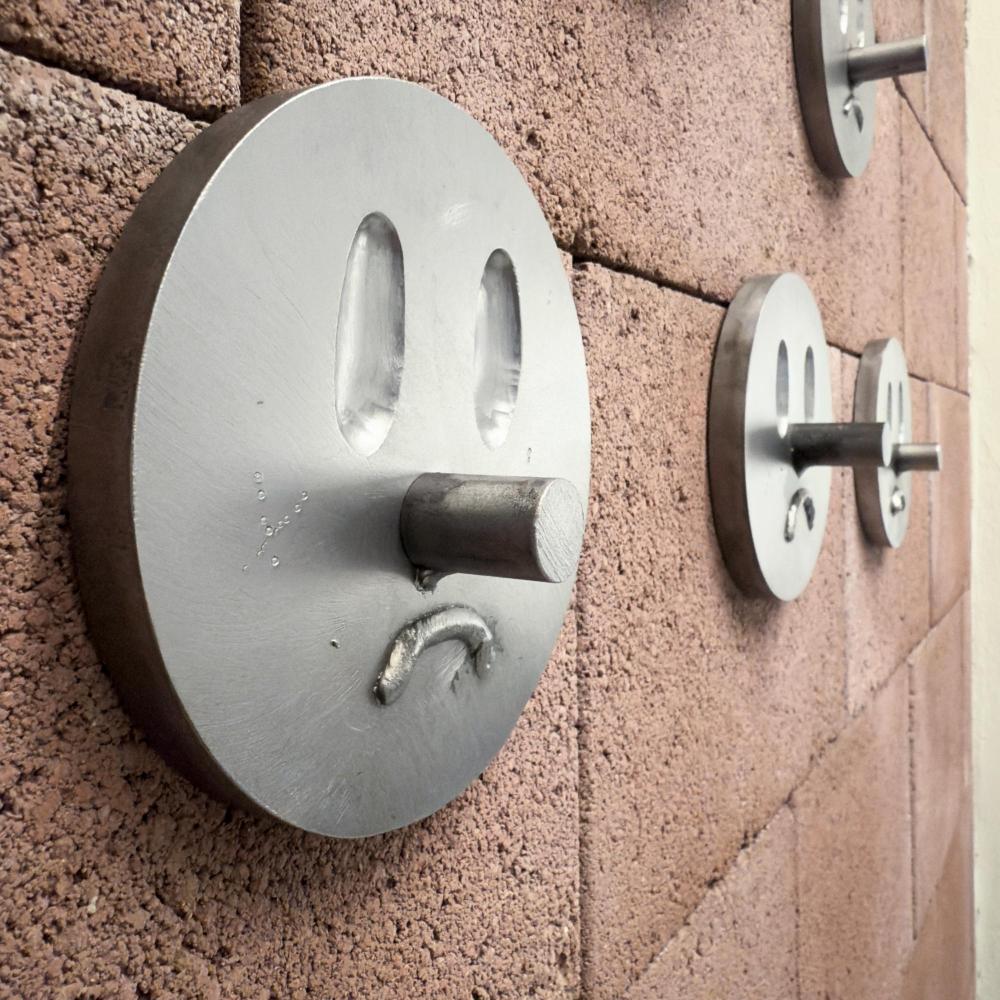
Jan Kudrna is a Czech curator of contemporary art, probably most closely associated with the Robert Runták Art Collection. He is also one of the founders of the Telegraph Gallery in Olomouc, where he served as chief curator for two years. Four years after the founding of Olomouc's largest contemporary art gallery, we asked him how he views its operation, exhibition schedule and future. We also delved into the waters of his work as a freelance curator and the projects he is currently working on.
Let's take a look at the very beginning of Telegraph Gallery. When was the idea of establishing a contemporary art gallery in Olomouc born?
The idea was born the moment Robert bought the house, which was around 2015. The following year the building was empty. During this period, there was an exhibition, mentioned by Robert several times, of his collection, which was spread over all three floors - there was no loft extension at the time - and lasted about three or four days for what was then an away meeting of the curators, the director and the acquisitions staff of Tate Modern, who were in Olomouc. The technical execution of the exhibition was in the hands of my brother and Zbyněk Hanečka, the chief technician of the Telegraph. Nobody knew at the time that there was art in the house, and art of such value in general. It was actually a very interesting event, kept secret from everyone. It was a kind of artistic premiere of the Telegraph. But at that time, during that exhibition, it was not yet known what form the Telegraph would one day take - there were different scenarios. In one of them, the Telegraph was going to have an extra floor, and a hostel was being considered...
The fifth floor probably posed a structural problem for the building?
Mostly yes, but there were more reasons. In another scenario, the Telegraph was supposed to be basemented again, but that didn't work because of the bedrock. But to return to the question, Robert was buying the building with the intention that the premises would one day house, among other things, a gallery. So you could say that the idea was born in 2015.
The first exhibition at the Telegraph Gallery was Václav Stratil: Heart in a Pincer. Why was Stratil's work chosen?
It was very simple, because in 2019 it was exactly thirty years since the revolution and the exhibition took place on the exact day. But there was also the symbolism of Stratil's exhibition in Olomouc, which took place on 17 November 1989. It was a double "anniversary". The building had not yet been completed at that time, and so the whole thing took place in quite specific conditions. We were mainly concerned with the revolutionary and the symbolism of the exhibition.
The opening was disrupted by a demonstration by students of the Brno FAVU. How did it go then and what were your feelings?
In retrospect, I think it was actually a good event. It was kind of expected and it helped the whole house. There's no need to look at things in black and white. The whole event, including the spray-painted sign on the facade, actually gave the Telegraph some "plasma" to start with.
How do you feel about the evolution of the Telegraph Gallery almost four years since its inception? You were curator for exactly half the time, two years.
A lot has changed in those four years. I don't want to say it's easier, but there are fewer exhibitions a year so there's more time to prepare - so getting the pressure on is more difficult now, but again it's at a stage where it's possible to enjoy it more. I think in terms of producing shows, we're talking about a completely different project in four years. The people who are here now are doing things more professionally and a lot of things are very well established. It's actually a "completely" different Telegraph. It's fun to watch and enjoy it in a slightly different way. Even though I still come here as somewhere I know from the ground up.
Are you still involved in the show schedule?
There are now three of us involved in the show schedule - myself, Mira Macík and Robert Runták. As far as the exhibition plan is concerned, it's always complicated. Even more so when it's only one exhibition space. There are a huge number of ideas that have to fit into a roughly three- or four-year horizon. There are a lot of ideas and a lot of people who would like to do something like that. That's why crash events at the cinema are fine - having one more space would be great. Of course, then everything would be much more challenging and you would have to think about how to balance the needs for producing such an additional space and what the space would give. One can always have and especially want a bigger house and space... But then there is the question of filling it and, more importantly, paying for it. People often don't realize that. It's not a platitude.
Haven't you considered just concentrating on the Telegraph? With your other projects, it must have been challenging.
It's always been challenging. I have one major project of my own that I'm working on, then I do eight or nine exhibitions a year, and combined with working for the Telegraph as chief curator, it was basically unsustainable. There were pressures in both my professional and private life that were not pleasant for either party involved. I stayed with the Robert Collection. I think the current situation is ideal for everyone.
The Telegraph often brings foreign artists to the Czech scene. Now there is a second exhibition under the baton of the British curator Jane Neal. How did Jane Neal come into contact with Olomouc's Telegraph Gallery?
Jane was introduced to Robert by a mutual colleague, Mark Sanders. I think it was sometime in 2015.
Please remind me again how long you and Robert have been working together?
Since early 2011.
How do the Telegraph Gallery and the Robert Runták Collection, of which you are the curator, work side by side? Are they two unrelated projects or are they conceptually intertwined?
They were initially intended to be completely strictly separate, which works in certain cases. But it's not entirely possible. Just by the Signal cycle alone, and also by the residencies from which the collection actually subsequently acquires the work(s). The connection is there. It's not big, but it's still there and will be.
So originally it wasn't intended to show Robert Runták's stuff at the Telegraph Gallery at all?
It was known that some work would occasionally be shown at the Telegraph before The Signal was created, but just as a home for the collection it wasn't entirely intended.
A series of Signal exhibitions? (note: regular exhibitions presenting works from the Robert Runták Collection)
Signal came about sort of automatically. I'd like it if we kept this pattern of exhibitions every few years. There's a great advantage of the unbiased view of a curator who didn't really know the collection before...
How did you yourself come to work in the contemporary art sector? I think you mentioned in an interview that you have only been actively curating since 2016 or 2017.
It started at GVUO, where I was the deputy director and where I had the opportunity to do some bigger projects of my own for the first time - I did a few exhibitions at that time. I started to do more of that when I left GVUO. These days, I'm lucky that I hear from the artists themselves. Sometimes I'm approached by galleries where I only have a deadline and I bring them someone they might be interested in. So every year I fill the capacity of five to eight exhibitions and I already have a couple of exhibitions planned for 2025. I enjoy exploring new places for exhibitions, often in combination with a particular artist. It remains crucial that I must be interested in a particular person, with the work of that person as a close second. When you have the opportunity to spend 2-3 days with someone in some sort of coherent process of installation and launch? That's still crucial for me. The human dimension.
Do you find working with space difficult?
Working with space is special to me in one way. I have "technical blood" in me originally (both my father and brother are engineers and designers), which probably accounts for the fact that I can always imagine a volume of space that I respect but never fear. Somehow an exhibition always comes together, even a space like the one we had available for the MEN exhibition in Hluboká, the Alš South Bohemia Gallery. If you work with quality things, it can't go completely wrong. The art and the works themselves decide. Almost always.
When you mentioned Alš's South Bohemian Gallery, how was the preparation for the exhibition MEN: The Male Body in the Robert Runták Collection? Did you have an architect for such a huge space?
I selected the works for the exhibition and I also worked with the architect Mirek Vavřina, whom I have known for a long time and I like his approach - he handles everything with a calm head. It is again the kind of meeting that is mainly a joy.
Could you tell us what major projects you have done in the recent past?
The biggest project was definitely the aforementioned MEN exhibition. I'm working on a project within myself that was supposed to be first an exhibition, then a book... but it's actually a project that probably can't be realized in the Czech Republic yet. I do have a concrete idea in my head, but we'll see how it all turns out. Then it's the Power Post Station exhibition in Trutnov EPO-1. Those were the two bigger projects.
You already mentioned the Zbyněk Sedlecky exhibition. What other projects are you looking forward to in the near future?
I have a project coming up in January at Bold Gallery with a young painter I only recently discovered, Kristýna Matalová. Then it will be Zbyněk Sedlecký and Karíma Al-Muktarová. All this until February 2024.







